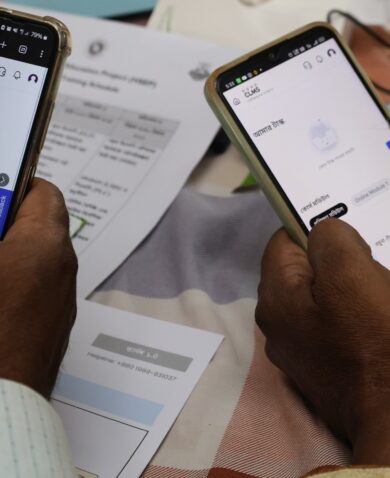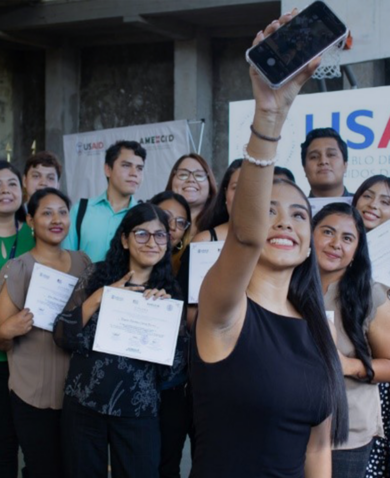
Creating a Win-Win for Youth and the Private Sector
September 11, 2018 | 3 Minute ReadWe know the importance of the private sector in development outcomes, but how do we ensure our youth workforce development programs are meeting the ever-changing demands of the labor market?
Across the world, 13.6 percent of youth are unemployed and almost 20 percent, or 260 million, are out of school. For those who manage to find a job, a staggering 17.1 percent still live below the extreme poverty threshold. The truth is that there are still too many young people who lack the education, skills, assets, and experience to thrive in today’s changing economy. Furthermore, the first global systematic review and meta-analysis of youth employment interventions reveals that only 30 percent of these programs show a significant impact on labor market outcomes (either through employment rates or earnings). This leaves considerable work to be done. As we strive to implement programs based on the evolving and contextual needs of youth, we must match these needs with movements in the private sector and ensure the private sector understands the value youth bring.
Private Sector Power
Across developing and emerging economies, the private sector is expanding and strengthening. Time and time again, the private sector drives the job creation and growth that reduces poverty and bolsters prosperity. According to the OECD Development Cooperation Directorate, the private sector, on average, provides 60 percent of gross domestic product, 80 percent of capital flows and 90 percent of jobs in developing countries. However, many private sector organizations hesitate to employ youth with few (or irrelevant) skills due to the considerable time, money, and resources required to train them. As a result, youth can be left behind very quickly.
Adapting with Youth and the Private Sector
The main objective of youth workforce development programs is to improve youth employment outcomes. One way to do this is through building skills and assets among youth. Skills training programs are the most useful when skills are tailored to actual market demands. A demand-driven approach, one that recognizes the needs of the private sector, can be transformative and it includes the following aspects:
- It uses real-time labor market information to determine high potential growth sectors and identify opportunities where there is a present or anticipated demand for labor
- It partners with employers to understand their business needs and learn about the skills that they need to see in employees
- It focuses on identifying misconceptions that employers might have about youth and vice versa
- It engages employers in the design of skills (both hard and soft) curricula to ensure that youth are trained on targeted and in-demand skills
- It develops training and work-readiness programs from youth that aim to mitigate the risks and concerns identified by organizations when they hire first-time workers
Beyond designing youth workforce development programs that reflect these aspects, it is imperative that demand-driven approaches adapt to changing private sector needs. The economy today is not what it was 10 years ago, and it will certainly be different 10 years from now. As the private sector adapts and organizations shift their business models, so too must youth workforce development programs. To ensure our effectiveness, we must continuously ask youth what they want, what’s working well, what can be improved, and what they envision for the future. We also must ask the private sector these same questions.
1. What do you want? Youth workforce development programs should continuously engage with youth to better understand their needs, opportunities, and challenges. At the same time, programs should talk with businesses to understand their current needs. By understanding what businesses want, we can match youth and private sector needs to better prepare young people for the labor market.
2. What’s working well and what can be improved? As we engage with youth, we need to make sure that we take the time to hear their voices — to understand what’s working and what isn’t. We also need to reflect with the private sector. If employers co-design skills training programs with development partners, we need to periodically check with them to see how their new hires are doing. Did the training program fully prepare that young person for the job he/she is now doing? Are there skills that he/she is still lacking? If so, how can we refine the training curriculum to better incorporate these skills? Establishing periodic focus groups between young people and the private sector is also important to ensure that both voices are heard.
3. What do you envision for the future? Youth needs will likely change over time, which is why it is critical to constantly engage them and adapt programs accordingly. Additionally, part of ensuring that demand-driven approaches are adaptive means keeping a constant pulse on the economy. Labor market analyses can become outdated very quickly, and it’s important that programs conduct ongoing, real-time, analysis. Engaging youth entrepreneurs to assist in conducting real-time labor market analyses can give us better insight as to what’s happening on the ground from a youth perspective.
To achieve our goal of increasing youth employability, we need to deepen our understanding of the young people we work with and private sector employers so that we can collaborate, co-design programs, and adapt together. As youth gain targeted skills and assets that are constantly refined with input from employers, we have a real chance to lower youth unemployment rates and boost economic productivity: a win-win for both youth and the private sector.
Blog posts on the Chemonics blog represent the views of the authors and do not necessarily represent the views of Chemonics.








































